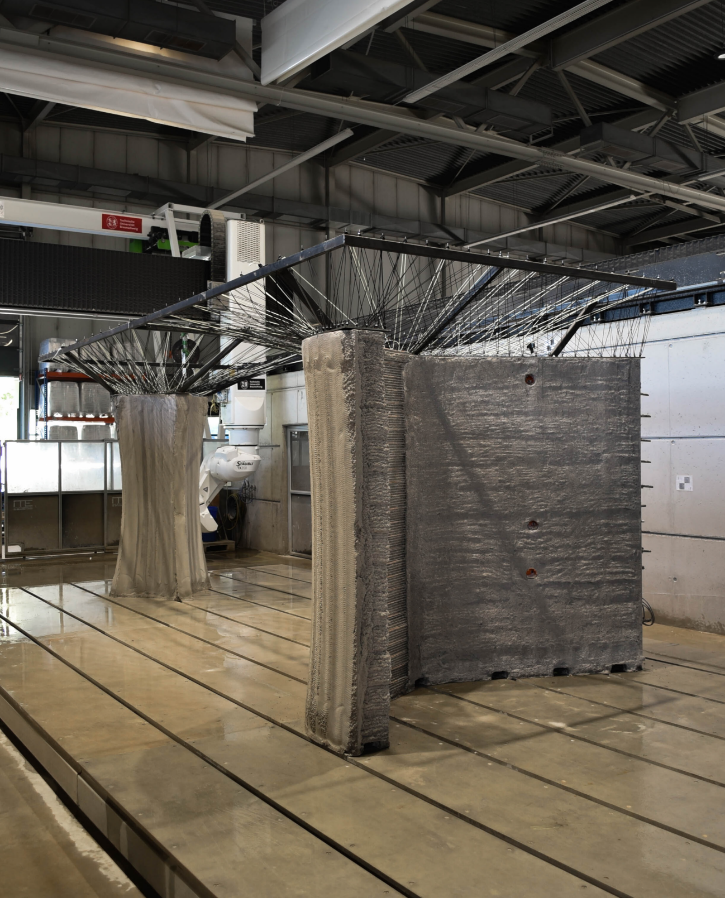Research Summary Report of A05
Integration of Individualized Prefabricated Fibre Reinforcement in Additive Manufacturing with Concrete
[29.09.2023]
Rothe, Tom; Doctoral researcher, t.rothe@tu-braunschweig.de, TU Braunschweig, Institute of Mechanics and Adaptronics (IMA)
Hühne, Christian; Project Leader, Christian.Huehne@tu-braunschweig.de, TU Braunschweig, Institute of Mechanics and Adaptronics (IMA)
| Fig 2: Robotic integration of reinforcement into the column of the Shelltonics demonstrator |
The individual integration of fibre reinforcement into large concrete components produced by Additive Manufacturing allows new design freedoms and reduces concrete consumption due to reduced concrete cover. The project A05 develops strategies to integrate freely formable reinforcement strands for the different AM processes. For doing so, a Dynamic Winding Machine is developed and constantly updated. This machine is used to consolidate and impregnate a primary fibre strand and wind a secondary yarn around it as a surface structuring. Thus, these reinforcement strands can be adapted for different purposes and enable more efficient production of highly customised, reinforced concrete elements.
Summary
Within the WG Hühne of A05, the individualized prefabrication of reinforcement strands by a developed Dynamic Winding Machine (DWM) is addressed, while WG Hack is focusing on strategies for the integration of the reinforcement strands into the different AM methods of the AMC.
The unique possibility of the developed Dynamic Winding Machine to produce windable reinforcement strands in different configurations and sizes is used to build large scale, reinforced demonstrators.
For the Shelltonics demonstrator (Fig. 1) the feasibility of two reinforcement integration strategies could be demonstrated in large scale. For the column of the demonstrator reinforcement has been integrated by winding a reinforcement strand spirally and continuously around it (Fig. 2). By configuring the DWM as a standalone machine and by using the integrated storage and tension unit, an application within the Digital Building Fabrication Laboratory (DBFL) was easily possible.
For the ceiling element the reinforcement integration technique of Frame Winding is used. The fibre strand is wound around pins on a frame. The resulting mesh structure can be processed into a reinforced ceiling structure in a further step using the Shotcrete process.
In addition to testing the application on a large scale, further material characterizations of the reinforcement strands have been carried out. Among other things, the fibre volume content and the fibre distribution within the reinforcement strand were investigated.Via thermogravimetric analysis (TGA) a fibre volume content of 62,22% with a standard deviation of only 0,61% and a void content of 1,96% could be detected, which surpasses the desired value of 60%. To study the fibre distribution over the cross section, it was examined under the microscope (Fig. 3).
Current state of research
The production of reinforcement structures for the Shelltonics demonstrator showed, that the strategies for reinforcement integration propagated and tested in medium sized structures are also applicable for large scale structures. Nevertheless, the experiments showed potential for improvement in various process aspects. Among other things, the path planning and prestressing of the reinforcement strand will be studied in detail in the next series of tests in order to be able to produce high-precision reinforcement structures.










